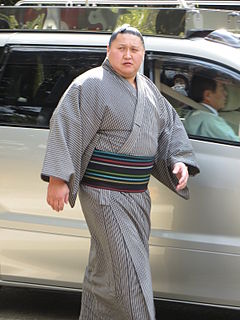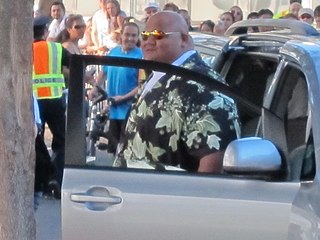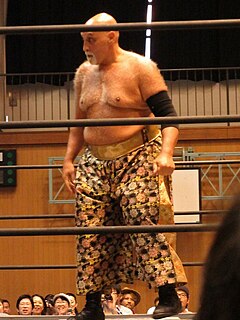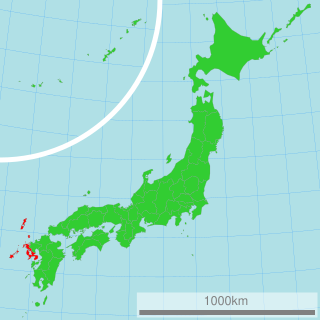Yoshimasa is a masculine Japanese given name. Notable people with the name include:

A rikishi (力士) sumotori or, more colloquially, sumosan, is a professional sumo wrestler. Rikishi are expected to live according to centuries-old rules and, although there are some exceptions, most come from Japan, where sumo is practiced exclusively. Participation in official tournaments is the only means of marking achievement in sumo and the rank of an individual rikishi is based solely on official wins.
Takamiyama Daigorō is a former sumo wrestler, the first foreign-born wrestler to win the top division championship. His highest rank was sekiwake. His active career spanned twenty years from 1964 to 1984, and he set a number of longevity records, including most tournaments ranked in the top makuuchi division, and most consecutive top division appearances. He is also the first foreign-born wrestler ever to take charge of a training stable, founding Azumazeki stable in 1986. His most successful wrestler was fellow Hawaiian Akebono who reached the highest rank of yokozuna in 1993. He retired as a coach in 2009.

Kyokutenhō Masaru in Nalaikh, Ulan Bator, Mongolia is a former professional sumo wrestler. He made his debut in March 1992 out of Ōshima stable, with the first group of Mongolians ever to join the sport in Japan, reaching the top makuuchi division in January 1998. In his exceptionally long career he received seven special prizes for Fighting Spirit, and won one yūshō, in May 2012 from the maegashira ranks, which made him at 37 the oldest first–time yūshō winner in sumo history, and he was runner-up in one other tournament. His highest rank was sekiwake, which he held on three occasions. He was the first wrestler since the 1950s to be ranked in the top division after the age of 40. He made more appearances in the top division than any other wrestler at 1470, and only Ōshio fought more than his 1870 career bouts. He announced his retirement in July 2015 and declared his intention to stay in sumo as an elder, having acquired Japanese citizenship in 2005. In 2017 he became the head coach of Tomozuna stable and he is known as Tomozuna-oyakata.

Kaiō Hiroyuki is a former professional sumo wrestler from Nōgata, Fukuoka, Japan.

Tochiazuma Daisuke is a retired sumo wrestler. He began his professional career in 1994, reaching the top division just two years later after winning a tournament championship in each of the lower divisions. After winning twelve special prizes and four gold stars, he reached his highest rank of ōzeki in 2002 and won three top division tournament championships before retiring because of health reasons in 2007 at the age of 30. In 2009 he became the head coach of Tamanoi stable.
Takeshi Inoue, known by his stage name Takeshi Rikiō, born December 20, 1972, is a Japanese retired professional wrestler, who worked for Pro Wrestling Noah. He is also a former sumo wrestler.

Teila Tuli, also known as Taylor Wily is an American actor and a former sumo wrestler and mixed martial artist. He is from Laie, Hawaii and is of Samoan descent. He is commonly known for his recurring role as Kamekona Tupuola on Hawaii Five-0.

Ōtake stable is a stable of sumo wrestlers, one of the Nishonoseki group of stables.
Chiyotenzan Daihachirō is a former sumo wrestler from Osaka, Japan. His highest rank was komusubi.

Kotozakura Masakatsu was a former sumo wrestler from Kurayoshi, Tottori, Japan. He was the sport's 53rd yokozuna. He made his professional debut in 1959, reaching the top division in 1963. After several years at the second highest rank of ōzeki, in 1973 he was promoted to yokozuna at the age of thirty-two years two months, becoming the oldest wrestler to be promoted to yokozuna since 1958, when the current six tournaments system was established. After his retirement he was head coach of Sadogatake stable and produced a string of top division wrestlers.

Kokkai Futoshi is a former professional sumo wrestler from Georgia. He began his career in May 2001. He is the first Caucasian rikishi to reach sumo's highest division, makuuchi, which he achieved in 2004. His highest rank was komusubi, which he reached in 2006. He earned two special prizes for Fighting Spirit and two gold stars for defeating yokozuna. He wrestled for Oitekaze stable.In April 2018 he was voted by unanimous decision to be the president of the Georgian Sumo Federation for a term of four years.
Wakanami Jun was a sumo wrestler from Iwai, Ibaraki, Japan. His highest rank was komusubi. He won a top division tournament championship in March 1968. He was also a sumo coach.

Hoshitango Imachi is an Argentine-born Japanese former professional sumo wrestler and current professional wrestler. His highest rank was Jūryō 3.

Wakashimazu Mutsuo is a Japanese former sumo wrestler from Nakatane, Kagoshima, Japan. His highest rank was ōzeki. He won two top division yūshō or tournament championships. He retired in 1987 and is now the head coach of Nishonoseki stable.
Ryōgoku Kajinosuke IV is a former sumo wrestler from Nagasaki, Japan. His highest rank was komusubi. He is now a sumo coach.
The following are the events in professional sumo during 2006.

Musashimaru Kōyō is a former sumo wrestler. He made his professional debut in 1989, and reached the top makuuchi division in 1991. After reaching ozeki rank in 1994 his progress seemed to stall, but in 1999 he became the second foreign-born wrestler in history to reach the rank of yokozuna. He won over 700 top division bouts and took twelve top division tournament championships during his career. Musashimaru's sheer 235 kg (518 lb) bulk combined with 1.92 m of height made him a formidable opponent, and he was remarkably consistent and injury-free for most of his career. An amiable personality, his fan base was helped by a surprising facial resemblance to Japanese warrior hero Saigō Takamori. After retiring in 2003, he became an elder of the Japan Sumo Association and founded the Musashigawa stable in 2013.

Kaisei Ichirō is a third generation Japanese Brazilian professional sumo wrestler (rikishi) from São Paulo, Brazil. Making his debut in September 2006, he reached the top makuuchi division in May 2011. His highest rank has been sekiwake. He has been runner-up twice, once in the July 2013 tournament and another in the March 2018 tournament. He has received three Fighting Spirit prizes to date.














